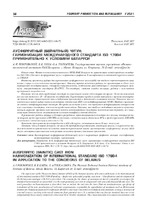| dc.contributor.author | Покровский, А. И. | |
| dc.contributor.author | Хина, Б. Б. | |
| dc.contributor.author | Толкачева, О. А. | |
| dc.coverage.spatial | Минск | ru |
| dc.date.accessioned | 2021-03-19T13:36:11Z | |
| dc.date.available | 2021-03-19T13:36:11Z | |
| dc.date.issued | 2021 | |
| dc.identifier.citation | Покровский, А. И. Аусферритный (бейнитный) чугун: гармонизация международного стандарта ISO 17804 применительно к условиям Беларуси = Ausferritic (bainitic) cast iron: harmonization of international standard ISO 17804 in application to the conditions of Belarus / А. И. Покровский, Б. Б. Хина, О. А. Толкачева // Литье и металлургия. – 2021. – № 1. – С. 56-72. | ru |
| dc.identifier.uri | https://rep.bntu.by/handle/data/88903 | |
| dc.description.abstract | Описан опыт Физико-технического института (ФТИ) НАН Беларуси по гармонизации международного стандарта ISO 17804 (Отливки. Аусферритный чугун с шаровидным графитом. Классификация) и созданию белорусского аналога СТБ ISO. Изложены аргументы выбора для гармонизации аусферритного чугуна (ADI) как наиболее перспективного по сравнению с серым и «классическим» высокопрочным. Описаны порядок включения работы по гармонизации в «План государственной стандартизации», специфика перевода текста, особенности взаимодействия с государственными органами, утверждающими стандарты (БелГИСС, Госстандарт), создания «сводки отзывов», работы с замечаниями предприятий-потребителей. Показано, что ни один зарубежный стандарт не существует сам по себе в отрыве от других. Он тесно взаимосвязан еще как минимум с 10 – 20 другими стандартами. Гармонизация требует увязки материала с другими стандартами (иногда даже справочниками) путем публикации приложений и дополнений к основному тексту. Показано, что исключительно важен выбор статуса стандарта: идентичный (IDT) или модифицированный (MOD). Наиболее престижно создать модифицированный стандарт. Но проблема состоит в том, что требуется модифицировать одновременно и все ссылочные стандарты, а это очень трудоемкая задача. Доказано, что наиболее подходящим является «промежуточный» вариант: принятие аутентичного текста международного стандарта (в качественном переводе), но с национальными дополнениями, отражающими местную специфику в данной области. В результате работы впервые в Беларуси pазработан гармонизированный стандарт для чугунов, который регламентирует предел прочности в 800 МПа в сочетании с относительным удлинением 10 %, и предел прочности 1400 МПа в сочетании с относительным удлинением 1 %. Выполнена примерная оценка потребности в ADI в Беларуси, составившая около 10 тыс. тонн в год. Показано, что в условиях Беларуси, где около 60 предприятий располагают литейными цехами, а термические отделения имеются практически на каждом машиностроительном заводе, высокопрочные аусферритные чугуны (ADI) могут составить существенную конкуренцию стальному прокату для многих применений. | ru |
| dc.language.iso | ru | ru |
| dc.publisher | БНТУ | ru |
| dc.title | Аусферритный (бейнитный) чугун: гармонизация международного стандарта ISO 17804 применительно к условиям Беларуси | ru |
| dc.title.alternative | Ausferritic (bainitic) cast iron: harmonization of international standard ISO 17804 in application to the conditions of Belarus | ru |
| dc.type | Article | ru |
| dc.identifier.doi | 10.21122/1683-6065-2021-1-56-72 | |
| local.description.annotation | The experience of the Physico-technical Institute (PhTI) of the National Acdemy of Sciences of Belarus in the harmonization of international standard ISO 17804 (Founding – Ausferritic spheroidal graphite cast irons – Classification) and development of the Belorussian analogue STB ISO is described. The reasons for the choice of austempered ductile iron (ADI) as an object for standard harmonization are presented: it is the most promising cast iron in comparison with gray and classical ductile iron. The work procedure on harmonization is described: how to include the task into the State Plan on standardization, specificity of translation of the text, peculiarities of with state organizations responsible for approbation of standards such as Belorussian Institute for Standardization and Certification (BelGISS) and State Committee on Standards (Gosstandart), writing a summary of external reviews, working with critical comments from potential users. It is outlined that any foreign standard does not exists independently but is closely connected with at least 10 to 20 other standards. Thus, harmonization necessitates coordination with other standards and sometimes even with handbooks by adding annexes to the main text. The importance of a proper choice of the standard status is outlined: identical (ID) or modified (MOD). Developing an identical standard is prestigious but difficult because is requires harmonization of all the referenced standards, which is a very labor-consuming procedure. It is argued that the most suitable is ‘intermediate’ variant: adopting the authentic text of the international standard (in high-quality translation) but with annexes reflecting national specificity in this area. As a result, a harmonized standard is developed which, for the first time in Belarus, standardize the tensile strength of 800 MPa in combination with the elongation of 10 % and the tensile strength of 1400 MPa in combination with the elongation of 1 % for cast irons. The annual demand for ADI in Belarus is estimated as about 10,000 ton. It is shown that in Belarus, where about 60 industrial enterprises have a foundry and almost every engineering plant has a heat-treatment shop, austempered ductile cast (ADI), which features a high strength, can successfully compete with rolled steel in certain applications. | ru |

